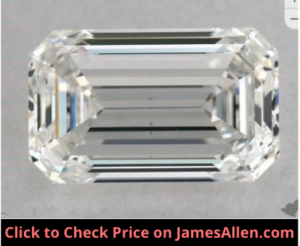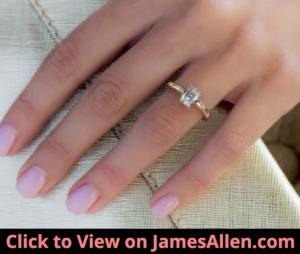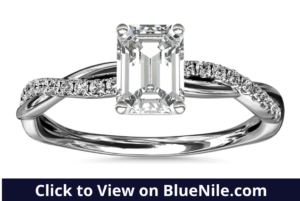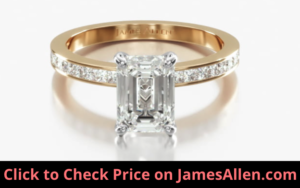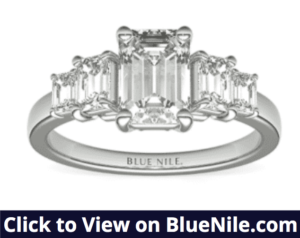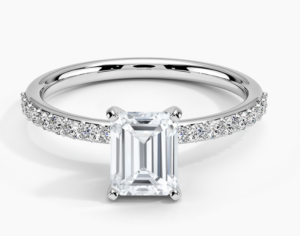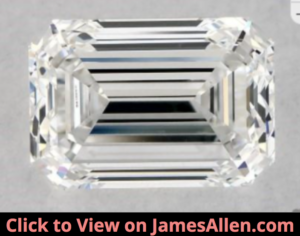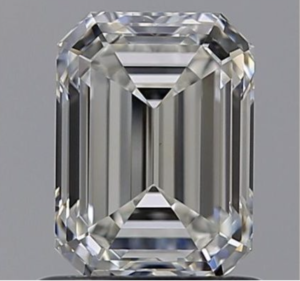
Emerald cut diamonds are a common choice as the center stone in engagement rings.
The distinguishing feature is their elongated shape and cropped corners. Linear facets run parallel across the diamond’s surface because it’s a step cut.
Its vintage aesthetic still pairs well with modern settings, so you’ll find them in all types, from the traditional solitaire to pave and channel.
Before you decide whether it’s right for you, it’s important to understand its traits and how it differs from other cuts.
Let’s explore 11 pros and cons of emerald cut diamonds.
Pros of Emerald Cuts
Appears Larger Than Other Cuts
The wide surface area of emerald cuts makes them appear larger than some other cuts of the same carat weight.
The size of a diamond is measured in carats, so two diamonds with the same carat weight are identical in size.
To the naked eye, this isn’t always the case. If you lined up one-carat diamonds of multiple shapes, such as Asscher, radiant, emerald, and round, they may look different sizes.
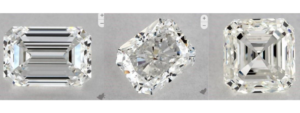
Compared to round brilliants, emerald cuts often look larger.
For example, many one-carat round cuts are 6.5 millimeters. Emerald cuts can measure seven by five millimeters. To illustrate, the cut below measures 7.10 x 4.37 x 3.709 mm.
This is true of cuts with a shallow depth.
In the image above, notice how the emerald cut is stretched, but the radiant cut in the middle and the Asscher cut on the right have more depth.
When the weight isn’t hidden under the table, the surface area appears larger. Emerald cuts are similar to oval and pear-shaped diamonds in this way.
If you’re most concerned about the size of your diamond but don’t want to pay a premium for a higher carat weight, you should consider an emerald cut.
Affordability
Emerald cuts are more affordable than brilliant cuts because they waste less of the rough diamond and there’s a lower demand. In fact, they’re one of the least expensive cuts.
In terms of price per carat, round and princess often command the highest prices.
For example, I compiled the average price for an emerald cut from James Allen, an online diamond retailer, with the following qualities:
- Carat weight: 1.00
- Color: H
- Clarity: VS2
The average price is $3,741, with a range of $3,090-$4,350.
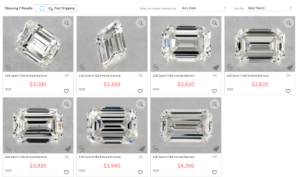
I also compiled prices for a round cut with the same qualities:
- Carat weight: 1.00
- Color: H
- Clarity: VS2
- Cut: Very good
They sell for an average of $5,838 and a range of $4,420-$6,650.
That’s a 35 percent average decrease in price for an emerald cut versus a round one.
If you’re looking for a more affordable option, choose a step-cut emerald diamond versus a brilliant one.
You could also opt for an emerald cut with a higher carat weight or better color or clarity grades for the same price as a brilliant cut with a lower weight.
Available in a Variety of Shapes
Another pro of emerald cuts is there are a variety of shapes. Some cuts, such as round, generally come in a single shape.
Emeralds, on the other hand, can stretch and contract to form rectangles or ones that resemble a square.
Take a look at the image of three emerald cuts below.
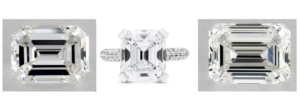
The one in the middle is shaped more like a square compared to the other two, which are clearly rectangular.
The length to width ratio of most emerald cuts is 1.30-1.50. The middle of this range is considered ideal, so many buyers opt for one close to 1.40.
Any diamond with a ratio of 1.0-1.05 will look like a square to the naked eye, but it’s rare to find an emerald cut with those specifications.
If you do select a square emerald cut, the ideal ratio is between 1.0 and 1.03. Anything between 1.08 and 1.20 is considered a lower quality cut.
Makes Fingers Look Slimmer
Your finger can look more slim or wide depending on the cut of your diamond.
Emerald cuts are often chosen by those with long, slim fingers because it accentuates that feature. It elongates their look in a way round, Asscher, and princess cuts do not.
This feature is apparent in the below image of an emerald cut engagement ring.
Notice how it’s placed vertically on her finger.
That being said, some buyers intentionally avoid emerald cuts because they don’t see this feature as complimentary.
That’s why it’s important to try on the diamond or view a high-quality image of someone wearing one before you decide whether it’s the right fit for you.
Cropped Corners Don’t Easily Chip or Snag
One of the downsides of diamonds with sharp corners is they snag more easily on hair, furniture, or other everyday items. This makes them vulnerable to chipping or breaking loose from their setting.
The cropped corners of emerald cuts are less prone to these issues. Instead of being cut with a sharp right angle, the corners have a smooth, diagonal edge.
In the emerald cut ring below, you can see how the prongs actually cover most of its edges, so it’s even more protected.
These four edges can better withstand hits and bumps compared to baguette and princess cuts.
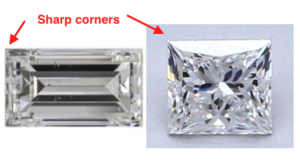
If you’re concerned about the durability of your diamond and preventing it from catching on clothes, an emerald cut reduces the probability of these issues.
Pair Well With Accents
An emerald cut can stand alone on a solitaire setting or be featured along other cuts. There are a variety of settings that include accents and pair with an emerald cut.
Check out this high-resolution image of an emerald cut engagement ring with channel-set diamonds.
Accents are placed within a crevice, which improves the sparkle of the whole piece.
As another example, this 14K white gold pave engagement ring includes small pave diamonds in addition to its emerald cut.
It adds sparkle to a ring that would otherwise lack exceptional brilliance because emerald cuts aren’t designed to maximize light performance.
Emerald cuts aren’t only used as the main diamond in an engagement ring. They’re also a popular choice for accents that complement the center stone either next to it or along the shank.
This four stone diamond engagement ring includes emerald cuts surrounding your choice of center diamond.
In my view, that’s too many emerald cuts on the same ring.
So if you want emerald cuts on your jewelry but are opting for another cut in the center, you could pair them with a round, marquise, oval, radiant, or princess cut.
These designs allow you to have a ring that showcases multiple cuts.
Cons of Emerald Cuts
Lacks Brilliance
Emerald cuts display less brilliance compared to round, princess, and cushion cuts. Those cuts are designed to maximize how much light enters the diamond and returns to the viewer.
They generally have a high number of facets, which are the surfaces that capture and reflect light.
Compare this emerald cut diamond ring to one with another cut.
Its lower number of facets is obvious, which is why this one includes tapered baguettes and round cuts to complement it.
The step-cut design of an emerald cut isn’t primarily concerned with light performance.
Other step-cut diamonds in the same category as emerald cuts are baguette, carré, and Asscher. The facets are rectangular or square and move up from the diamond’s table like a set of steps.
For an emerald cut, this is known as a “hall of mirrors” effect.
Shows Inclusions
Inclusions are imperfections in a diamond that can affect its appearance, durability, and brilliance. These flaws include:
- Twinning wisps
- Feathers
- Cavities
- Etch channels
The presence of blemishes impacts the overall clarity of a diamond.
The primary quality that prevents visible inclusions is brilliance because the light reflecting from the diamond acts as a cover. That means emerald cuts don’t hide inclusions as well as brilliant cuts.
A round cut with an SI1 clarity often doesn’t have visible inclusions, but this isn’t the case for emerald cuts. Instead, you’ll have to choose one with a higher clarity grade.
This diamond earned a VVS1 clarity grade, which means it’s eye-clean.
But you don’t have to go that high on the clarity scale to achieve that affect. Emerald cuts that earn a VS1 or VS2 grade allow you to avoid the premiums charged for high clarity grades while also being eye-clean in most cases.
So start your search at VS2 and move up if necessary.
Emerald cuts are also susceptible to windowing. It’s a large black line that extends across the diamond.
Most cases of windowing are easily visible to the naked eye, so you can avoid this issue by viewing a high-quality image or seeing it in person before buying.
Shows Color
A diamond’s color grade indicates the presence of yellow or brown tints. Colorless diamonds earn the highest grades, and more yellow or brown moves it into categories such as:
- Near colorless
- Faint
- Very light
- Light
Many of the principles that apply to clarity are also relevant for an emerald cut’s color. You should be most concerned with its appearance to the naked eye, which means you don’t need to choose a D color grade.
A disadvantage of emerald cuts is they require higher color grades to appear colorless to the naked eye when compared with round cuts. While round cuts often look colorless with grades I or above, start your search for emerald cuts at H.
If you go below that, the yellow is often apparent.
Its large table allows the viewer to see deep into the diamond.
Instead of the many facets in a brilliant cut collecting light and bouncing it around inside the diamond, the yellow tints are stronger in a step-cut emerald.
GIA Doesn’t Provide Cut Grade
The cut of a diamond is the quality that most impacts its brilliance.
It’s a trait that combines other characteristics of a diamond such as its symmetry, depth, polish, and proportions.
You can see on the GIA report below that each of these measurements are noted on the report.
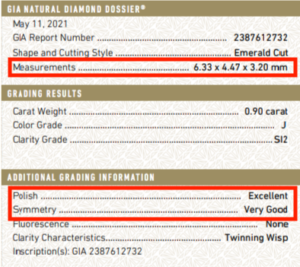
The GIA doesn’t provide cut grades for fancy shapes such as emerald cuts in the same way its grades color and clarity. In the report above, the grading results include carat weight and color and clarity grade, but cut is missing.
There isn’t a consistent way to grade their quality. Instead, the GIA gives grades on many of the qualities that make up cut.
By examining its grades for symmetry and polish, in addition to its girdle thickness and overall measurements, you can determine the quality of its cut.
You should still view the diamond in person or online because you can’t know the exact quality of its cut only from the certificate.
Fewer Options Available
Industry estimates put emerald cuts as the fifth most popular cut.
Many sellers have more options available for round, princess, and cushion cuts, so if you’re looking for the cut with the most diamonds to choose from, you should consider one of those.
For example, Blue Nile is an online diamond retailer with one of the largest inventories.
It offers 46,500 round cuts of 0.75 carats or higher. It sells more than 7,000 cushion cuts but only 5,200 emerald cuts.
At James Allen, its inventory of diamonds 0.75 carats and up includes:
- Round cuts: 50,700
- Oval cuts: 11,000
- Emerald cuts: 7,000
This is still plenty to choose from, but those numbers start to dwindle when you filter them for your preferred carat weight, color, cut, and clarity.
The same is true if you visit diamond retailers in person. They’ll likely have fewer emerald cut diamonds in stock compared to others.
How to Decide if an Emerald Cut Diamond is Right For You
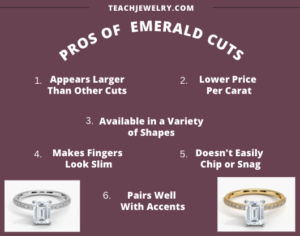
Every diamond cut has its benefits and downsides related to popularity, clarity, color, and overall style. Emerald cuts aren’t an exception.
Know the features of emerald cuts, so you make the most informed decision. Here are some helpful tips.
An emerald cut may be right for you if:
- You want a rectangular or square shaped diamond that’s also durable
- You’re interested in an alternative to traditional round cuts
- The elongated look of a step-cut is appealing to you
- You’re looking for a diamond with a lower cost per carat
- You’re willing to choose a higher clarity and color grade so it appears eye-clean and colorless
Consider the pros and cons of emerald cuts and how it can serve as the center diamond in an engagement ring or as accents on any piece of jewelry.

Jacob Clarke
Jacob Clarke is the founder of TeachJewelry.com.
He earned an Applied Jewelry Professional Diploma from the Gemological Institute of America (GIA) and now brings you essential information about diamonds, settings, and more.
Jacob has consulted with leading jewelry brands, and his work has been cited in Clean Origin, Diamond Nexus and industry publications.
He's also a member of the International Gem Society.
He enjoys discussing jewelry with readers, so contact him with any questions at jacob.clarke@teachjewelry.com.

